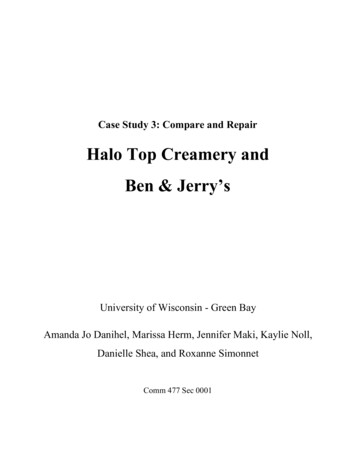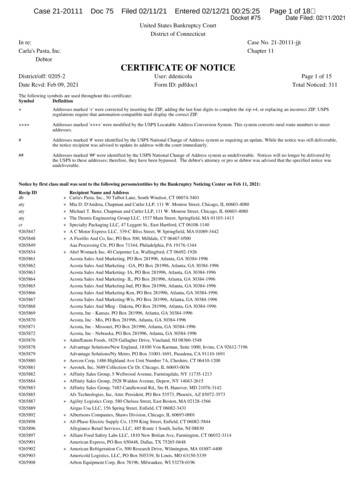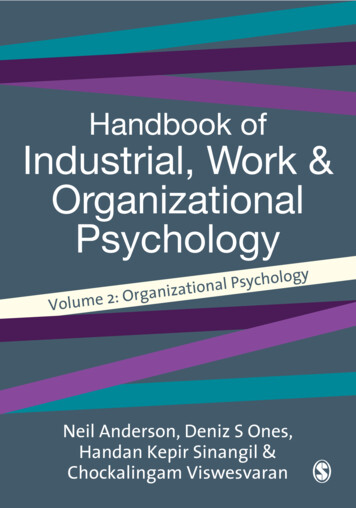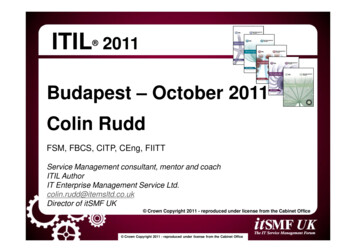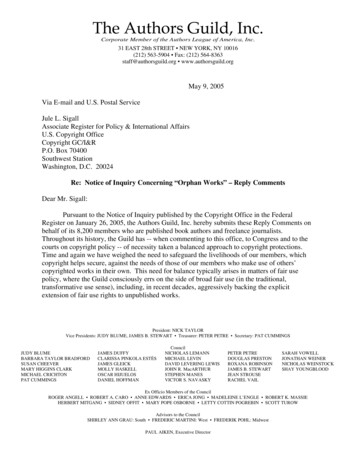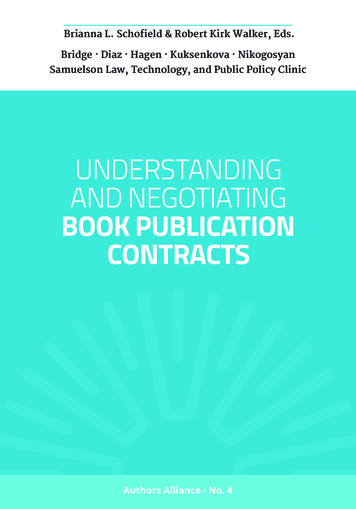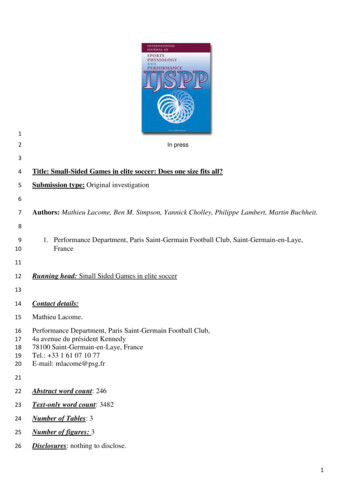
Transcription
12In press34Title: Small-Sided Games in elite soccer: Does one size fits all?5Submission type: Original investigation67Authors: Mathieu Lacome, Ben M. Simpson, Yannick Cholley, Philippe Lambert, Martin Buchheit.89101. Performance Department, Paris Saint-Germain Football Club, Saint-Germain-en-Laye,France1112Running head: Small Sided Games in elite soccer1314Contact details:15Mathieu Lacome.1617181920Performance Department, Paris Saint-Germain Football Club,4a avenue du président Kennedy78100 Saint-Germain-en-Laye, FranceTel.: 33 1 61 07 10 77E-mail: mlacome@psg.fr2122Abstract word count: 24623Text-only word count: 348224Number of Tables: 325Number of figures: 326Disclosures: nothing to disclose.1
27281. Abstract29Purpose: To compare the peak intensity of typical Small Sided Games (SSGs) with those of official30matches in terms of running demands and mechanical work over different rolling average durations31and playing positions.32Method: Data were collected in 21 players (25 5 y, 181 7 cm, 77 7 kg) belonging to an elite French33football team. SSG data were collected over two seasons during typical training sessions (249 files,3412 4 per player) and official matches (n 12). Players’ locomotor activity was recorded using 15-Hz35GPS. Total distance (TD, m), high-speed distance (HS, distance above 14.4 km.h-1, m) and mechanical36work (MechW, a.u) were analysed during different rolling average periods (1 to 15 min). The SSGs37examined were 4v4 Goal Keepers (GKs), 6v6 GKs, 8v8 GKs and 10v10 GKs.38Results: Peak TD and HS during 4v4, 6v6 and 8v8 were likely-to-most likely largely lower than during39matches (ES: -0.59, 0.38 to -7.36, 1.20). MechW during 4v4 was likely-to-most likely higher than40during matches (1-4-min; 0.61 ,0.77 to 2.30 ,0.64). Relative to their match demands, central41defenders (CD) performed more HS than other positions (0.63 ,0.81 to 1.61 ,0.52) during 6v6.42Similarly, central midfielders (CM) performed less MechW than the other positions during 6v643(0.68, 0.72 to 1.34, 0.99) and 8v8 (0.73, 0.50 to 1.39, 0.32).44Conclusion: Peak locomotor intensity can be modulated during SSGs of various formats and durations45to either over- or underload match demands, with 4v4 placing the greatest and the least emphasis on46MechW and HS, respectively. Additionally, CD and CM tend to be the most and least overloaded47during SSGs, respectively.4849Key words: Small sided games, soccer, peak intensity, match demands, periodisation,502
51522. Introduction53While it is important for football players to have well-developed physical and physiological54qualities,1 match contextual factors2 often prevent highly-trained players to fully utilise their physical55potential during matches. Indeed, it has been shown that in the case of an early player dismissal, the56players remaining on the pitch could increase their running performance individually to maintain57overall team running performance.3 Additionally, elite young CM and strikers have been reported to58only reach 85 to 94% of their maximal sprinting speed during matches, respectively.4 The current59understanding is that elite football players do not necessarily require to be the fittest athletes but at60least, fit enough to cope with the demands of the match and execute their tactical role efficiently.61As such, during recent years, soccer training concepts and methodologies have evolved towards62more integrated types of physical training, i.e., training with the ball under match-derived situations,63which prioritises both the quality and the density of players’ specific actions and inter-communication64over pure physical development. This systematic training approach is often referred to as ‘the tactical65periodization model’;5 its key principle is the overload, relative to match demands, of each of the three66main fitness components (strength, endurance, speed) within a football-specific manner during the67week, rather than throughout a single session. Besides the specific tactical principles that every coach68aims to implement during sessions, it has been shown that match-overload could be reached, and in69turn, football-fitness developed using (at least partially) small sided games (SSGs).6 In fact, with70appropriate formats (e.g., number of players, area, rules), SSGs can be associated with high71occurrences of player interactions (as a function of the decreased number of players and reduced space)72and intense physical demands.7 Training programs over several weeks including SSGs have reported73improvements in various match winning-related factors including technical proficiency, tactical74awareness, speed, strength and endurance performance.6,8-1075Nevertheless, the typical SSG formats that are most likely to target specific physiological76attributes, as required within the tactical periodization model, are still unknown. Surprisingly also, is77how the locomotor intensity of commonly-used SSGs compare to that of matches is unknown. This is78somewhat surprising since within the tactical periodization model, most exercises are organized in79comparison to match demands to ensure an optimal work/recovery balance from one day to the80following.5 One of the challenges to assess match demands is that the intensity and density of actions81is likely time-independent, i.e., the longer the period, the lower the average intensity. For that reason,82it is difficult to compare the locomotor intensity of different SSG formats of various durations with the3
83demands of a 90-min game. To shade light upon this important question for practitioners, the match-84related locomotor intensity vs. time relationship during matches can now be modelled using a power85relationship.11 This latter study in professional soccer established the duration-specific profile of peak86running periods from 1 to 90 min. As time approached zero, relative distance peaked between 170 and87200 m.min-1, depending on positions. While these results can provide coaching staff with clear88information on peak match intensity over various time periods, comparing training drills such as SSGs89has never been examined, so that it remains difficult to translate these match-related information into90actual training content.91To examine at which extent different SSG formats could be used to either under- or overload92the running- and/or mechanical- demands of competitive matches, we first compared using power law93modelling the peak locomotor intensity of different typical SSGs with those of official matches in94terms of running demands and mechanical work over different rolling average durations. A second95objective of the present study was to examine the effect of playing positions on the magnitude of the96differences in locomotor intensity responses between SSG and matches, which should help coaching97staff to better individualise their training plans.98993. Methods100101Participants:102Data were collected in 21 players (25 5 y, 181 7 cm, 77 7 kg) belonging to an elite French football103team (qualified for the last stage of the Champion’s league competition) during two consecutive104seasons (2014-2015 and 2015-2016). Players were grouped according to their playing position, as105central defender (CD: n 4), wide defender (WD: n 6), central midfielder (CM: n 6) and forwards106(AM: n 5). These data arose from the daily player monitoring in which player activities are routinely107measured over the course of the season. Therefore, ethics committee clearance was not required.12 The108study conformed nevertheless to the recommendations of the Declaration of Helsinki.109110Study Overview111All match data were collected during both pre-season friendly (n 7) and competitive (French League1121, n 5) matches, with the team systematically playing in a 4-3-3 formation for a total of 64 player4
113match observations. Only data from players who completed the 1st half of the match were analysed in114order to limit the effect of pacing strategies or possible performance decrement toward the end of the115match.2 All SSG data were collected in-season on a hybrid turf (DESSO GrassMaster, Tarkett,116Nanterre, France) during typical training sessions. Players’ activity was recorded using 15-Hz GPS117(SPI-Pro, Team AMS R1 2016.8, GPSports, Canberra, Australia) and analysed using Athletic Data118Innovations analyser (v5.4.1.514, Sydney, Australia)13 to derive total distance (TD, m), high-speed119distance (HS, distance above 14.4 km.h-1, (m)) and mechanical load (MechW, a.u) during different120rolling average periods (1, 2, 3, 4, 5, 6, 8, 10, 12 and 15 min). To limit inter-unit error, each player121wore the same unit throughout the course of the two seasons.14 MechW is an overall measure of122velocity changes and is calculated using 2m.s-2 accelerations, decelerations and changes of direction123events.15 It reliability and validity is in the same range of acceleration and deceleration variables using124the same technology. To smooth the data and make sure the greatest high-intensity periods would be125captured,16 an overlapping between the successive windows (1 to 15-min duration) was applied. The126duration of the overlapping was set either as 20% of the period length (for 1 to 5-min rolling average127periods, i.e., 12 s to 1 min overlapping) or as 1 min (remaining longer durations windows). The peak128value obtained for each SSG and match for each variable was recorded. Figure 1 shows, in a129representative player, peak activities during the different SSGs compared with match demands (gray130zone, as mean standard deviations to mean - standard deviations) as a function of each rolling average131period.132133Small-Sided Games134Only the most standardised SSGs (3 touches max) over the two seasons were used for analysis: (1)1354v4 goal keepers (GKs), n 27 game observations, dimensions: 25x30m, surface area per player: 71 6136m2, 6 repetitions, time on: 3 min, time off: 90 s, (2) 6v6 GKs, n 46, 30x40m, 87 8 m2, 4 repetitions,1374 min; 2 min, (3) 8v8 GKs, n 50, 40x40m, 106 6 m2, 2 repetitions, 10-min, 3-min and (4)13810v10 GKs, n 62, 102x67m, 311m2, 1 repetition, 30-min, 0-min. During SSGs, the ball was always139available by prompt replacement when out.6 SSGs were analysed from the start of the first to the end140of the last repetition, including resting periods.17 Since recovery periods are generally considered as a141part of the overall exercise load,18 we chose to analyse the complete exercise block as a whole (i.e., 18142to 30-min sequences, including 1 to 6 repeated SSG drills.143Run-based high-intensity training5
144To further contextualise the demands of the different SSGs and match play, we also provided, as a145unique example, the locomotor demands a typical run-based high-intensity training (HIT) drill (6-min146set with 15-s runs at 100% of maximal aerobic velocity interspersed with 15 s of passive recovery.)147Locomotor Intensity Modelling148To model the relationship between locomotor intensity and moving average durations for each of the149three variables, a power law relationship19 was used using the formula: 𝑖 𝑐𝑥 𝑛 , where i is the150running/mechanical load intensity, c the intercept and n the slope of the relationship.11151Statistical analyses:152Data in text and figures are presented as means with standard deviations (SD) and 90% confidence153limits/intervals (CL/CI). All data were first log-transformed to reduce bias arising from non-uniformity154error. Differences in locomotor intensity between each SSG and match activity in the different155variables, as-well-as between-SSG/position differences relative to match, were examined using156standardised differences (ES), based on Cohen’s effect size principle. Probabilities were used to make157a qualitative probabilistic mechanistic inference about the true changes/differences in the changes,158which were assessed in comparison to the smallest worthwhile change (0.2 x pooled SDs). The scale159was as follows: 25 75%, possible; 75 95%, likely; 95 99%, very likely; 99%, almost certain.160Threshold values for standardized differences were 0.2 (small), 0.6 (moderate), 1.2 (large) and161very large ( 2). For simplicity and greater impact of the present results in the field only effect sizes 1620.6 with likely chances ( 75%) that the differences were true were reported in tables 2 and 3.1631644. Results165Table 1 presents slopes, intercepts and regression coefficients of the models (r 0.94-1.00) that166describe the associations between TD, HS and MechW intensity vs. rolling-average durations, for each167SSG and position. Figure 3 presents the standardised differences in TD, HI and MechW intensity168between each SSG and match demands for all rolling average durations and positions.169Overall, TD and HS were likely-to-most likely lower during 4v4, 6v6 and 8v8 than during matches for170all positions and rolling average durations. For CD and CM, TD was likely-to-most likely higher171during 10v10 than during matches for almost all rolling average durations. Unclear or trivial172differences were observed in HS between 10v10 and matches for all positions. MechW was likely-to-173most likely higher during 4v4 than during matches for all positions and short-duration rolling averages6
174(1-4-min). MechW was likely-to-most likely higher during 6v6 than during matches for CD (2-15-175min) while only unclear-to-small differences were observed for all other positions. Unclear-to-small176differences in MechW were observed between 8v8 and matches for WD and AM.177Table 2 presents the between-SSGs standardised differences in HS and MechW intensity as a function178of rolling average durations. Overall, HS increased with increases in player numbers. HS was most179likely superior for 10v10 compared with 4v4, 6v6 and 8v8 for all rolling average durations (ES:1802.79, 0.54 to 3.97, 0.53). Overall, MechW intensity decreased with increasing player numbers.181MechW was very-to-most likely higher for 4v4 compared with 6v6 (1-3-min rolling average duration,182ES: -1.14, 0.52 to –1.25, 0.38), 8v8 (1-4-min, -0.69, 0.39 to -1.61, 0.32) and 10v10 (1-4-min, -1831.26, 0.40 to -1.96, 0.37). MechW was very-to-most likely higher for 6v6 compared with 8v8 (10-18415-min, -0.64, 0.40 to -0.70, 0.29) and 10v10 (2-15-min, 0.65, 0.32 to 1.02, 0.26). MechW was very185likely higher for 8v8 compared with 10v10 over 8 min (0.69, 0.35).186Table 3 presents the between-position standardised differences as a function of rolling average187durations for HS and MechW intensity, for each SSG. Overall, CD covered likely-to-most likely more188HS, relative to their match demands, compared with CM and AM during 6v6 for all rolling average189durations (0.63, 0.81 to 1.59, 0.96) as well as likely more than WD (1-min; -0.89, 0.97) and AM (1-1902 and 8-min, -0.58, 0.36 to -1.54, 1.84) during 8v8. CM covered likely more HS relative to the match191than WD (3-4-min; 0.89, 1.05 to 0.95, 1.10) and likely-to-most likely more than AM (4-6-min;1920.87, 0.80 to 1.32, 1.13) during 8v8. Regarding MechW, CM worked less compared with their own193matches than the other positions during 6v6. Similarly, CM performed likely-to-most likely less194MechW than CD (5-15-min; 0.68, 0.72 to 1.34, 0.99) and AM (4 and 6-15-min; 0.82, 0.43 to1951.06, 0.60). CM performed likely-to-most likely less MechW than CD (1-15-min, 0.69, 0.81 to1961.11, 1.09), WD (12-15-min, 0.79, 0.77 and 0.92, 0.77 respectively) and AM (3-15-min, 0.60, 0.60197to 1.39, 0.32) during 8V8. All other between-group or between-SSGs differences in peak TD, HS or198MechW were small and/or unclear.199TD and HS intensity during a typical run-based high-intensity training (HIT) session was likely slightly200higher (1-min TD: 180 16 vs 186 3m; ES: 0.38, 0.37) to almost certainly very largely higher201compare with the match (6-min TD: 128 12 vs 168 4m; 2.72, 0.35; HS: 36 8m vs 118 3m;2025.13, 0.37). MechW was almost certainly very largely lower (ES: -10.5, 0.37 to -7.58, 0.37) during203HIT than the match.2042055. Discussion7
206207To our knowledge, this study is the first to compare the locomotor intensity (i.e., running activity and208mechanical work) of typical SSGs with that of competitive matches in professional soccer players. The209main findings of this study were: (1) Compared with matches, only 10v10 SSGs (102x67m) allowed210players to reach similar running intensities (TD and HS), whereas 4v4 (25x30m; over 1-4 min) allowed211the attainment of a moderately-to-largely greater mechanical work intensity, (2) The magnitude of the212differences in locomotor intensity between SSGs and matches was highly position- and SSG-213dependant, irrespective of the rolling average durations.214In the present study, we used a power law model to examine the relationship between running-215and mechanical work intensity and time during official first league matches and a selection of typical216SSGs. Interestingly, the peak running intensity reported in our study (intercept; 146.8 to 176 m.min-1217for CD and CM, respectively) was 10- 15% lower than that reported in professional Australian A-218League players,11 despite the fact that the two teams played in a similar 4-3-3 formation. However, the219actual playing style (possession vs direct- or fast-progression playing style,20) and playing standard220(one team playing the European Champions’ League vs one playing in the Australian domestic221championship) may influence match running demands at a greater extend than team formations. The222high technical standard of the French team players and the high possession scores during matches223( 65%) is, therefore, likely to explain the differences observed between the studies.224Differences between SSGs and match demands & Implication for Tactical Periodisation225In the present study, we found that the overall running intensity (TD and HS) during 4v4, 6v6 and 8v8226were likely-to-most likely and slightly-to-very largely lower than during matches for all positions227(Figure 2). In contrast during 10v10, TD and HS were similar or even slightly-to-moderately higher228than during matches (Figure 2). This latter result confirms previous work7,21,22 showing that increasing229the number of players (and concomitantly pitch size) increases TD and HS during SSGs. In fact, an230increase in relative playing area (from 90 (4v4) to 310m2/player (10v10)) allows for more space to231be covered (high TD,23) and in turn, higher speeds to be reached (HS,24). In this study, the space232available for players to run increased directly with player number, so that the greater number of players,233the greater the distance per minute ran. Over the past years, soccer training concepts and methodologies234have evolved and one of the most contemporary training approaches in soccer is now called the235“Tactical periodization”.5 With this approach, horizontal alternation of the training goals is achieved236by prioritising either strength, endurance or speed focus between days rather than between exercises237or microcycles. The aim of each ‘conditioned’ session is then to overload the desired fitness component8
238relative to the match demands. During an “endurance-targeted session”, in parallel to a high metabolic239load, coaches generally aim for a relatively high average running pace (m/min) and large activity240volumes.18 Therefore, from a pure locomotor standpoint, while the 4v4, 6v6 and to a lesser extent the2418v8 might not allow overloading the running loads of endurance-oriented sessions, the 10v10 is likely242the optimal format to program during submaximal endurance-oriented sessions. Notwithstanding, the243magnitude of the difference between 10v10 and matches locomotor intensity was only trivial-to-small244(182 vs 180 m/min for 1-min to 121 vs 117 m/min for 15-min for SSG and matches, respectively). As245such, to substantially overload TD and HS intensity over longer periods of time, specific run-based246high-intensity training (HIT) drills without the ball may sometimes still need to be incorporated into247training sessions (i.e., intermittent runs such as 15-s on – 15-s off; Fig 1, 118 vs 36 m/min at HS for 6248min for example, very large effect). In practice, however, coaches may also use 6v6 or 8v8 SSGs249within their endurance-oriented sessions; not for their locomotor demands but because of the250associated high but not maximal metabolic responses (high heart rate responses (see Hill-Haas et al.24,251Figure 3)), which were not examined in the present study), which when programmed over prolonged252durations (e.g., 8 min for 6v6 and 15 min for 8v8) may help to improve the ability to maintain high253work rates over time (i.e., endurance).254On the other hand, MechW intensity was likely-to-most likely higher during 4v4 than during matches255for short-duration rolling averages (Figure 2). This result confirms previous work where a decrease in256player numbers tended to increase player actions and changes in velocity (accelerations and257decelerations),21,22 which could, in turn, overload mechanical work intensity compared with match258demands.25 Interestingly, MechW was also higher than match demands during 6v6 for CD (but not the259other positions, small and/or unclear differences, Table 3), suggesting that this format could also be260used to overload MechW for this position. Since during a “strength-targeted session”, coaches261generally tend to overload players’ neuromuscular system through increased occurrences of262accelerations, decelerations and changes of directions at high intensity, present results confirm the263interest of using 4v4 (and 6v6 for CD) over 3-5 min to overload this specific soccer-specific physical264capacity. However, it is noteworthy that the overload in MechW intensity is likely substantial for short265SSG bouts only ( 5 min); as currently implemented in practice, it is therefore preferable to use short266repetitions interspersed with long recovery durations (90-120 s) to promote peak MechW intensities.267Finally, it is also worth noting that the metabolic responses to such SSGs are almost near-to-maximal268(not measured here,18), which shows again that during such football-specific drills it is impossible to269train physical capacities in complete isolation. These formats may however be better suited to develop9
270maximal aerobic ‘power’ than endurance per se, which explains why this SGG format fits better into271locomotor ‘strength-’ than ‘endurance-oriented’ conditioned sessions.272273The magnitudes of difference between SSGs and matches are position-dependant274Another area of concern when planning training in overall, and especially SSGs, is the possible275heterogeneity of physical responses between individuals, which can cause disparities in player’s276weekly loading.17 In this study, there were some substantial differences in relative locomotor intensity277responses between positions (Table3). For example, relative to their respective match demands, CD278performed likely moderately greater HS than CM during 6v6, while these latter players performed279moderately-to-largely more HS than WD and AM during 8v8 (Table3). On the other hand, CM were280moderately under-loaded for MechW during 6v6 and 8v8 compared with other positions. With these281results in mind, coaches may propose regulation rules or specific exercises to unload/overload282individual player groups and in turn individualise the overall training intensity and load.13 On one283hand, when the aim is to decrease running load, players can be used as floaters or positioned off the284pitch as wide players.24 On the other hand, to specifically overload a group of players, player-to-player285marking could be requested.26 Reported elsewhere, it is also worth noting that game modulation can286be achieved through creating ‘artificial’ rule changes with players required to complete series of287accelerations and decelerations before returning into the area of play,24,27 increasing MechW intensity288of the drill. However, while rule modifications in SSGs are widely used in professional football to289unload or top-up specific players, their specific impact on locomotor and/or mechanical work intensity290have not been clearly investigated and require further investigation. Finally, since these rule291modifications may in fact lack specificity, it may be more appropriate to, at least, modify the exercise292volumes for these latter specific player groups, e.g., CD performing ¾ of the game-specific part of the293session and CM, additional run-based drills at the end of the session. It is however worth mentioning294that the present results may be exclusively representative of the team examined here; team adopting295different systems and types of play may show different match play demands,28 which may affect, in296turn, the comparisons with the SSGs examined here. It is also noteworthy that the relatively small297sample size used in this study could potentially limit the confidence in the positional group298comparison.2993006. Practical applications30110
302 10v10 (5-15-min) SSGs can be used to slightly-to-moderately overload the intensity of match303locomotor demands (TD and HS) and may be well suited for endurance-oriented sessions304within a tactical periodization training paradigm.305 3063074v4 ( 5-min) and to a lesser extent 6v6 SSGs (2-15-min, CD) can be used to overload MechWintensity. SSGs are not a one size fits all training weapon when it comes to players loading. Planning308position-specific unloading strategies or top-up exercises are likely required to equilibrate309players loading relative to game demands when using SSGs.310 A D 1 session for substitutes that aim to compensate for a 60-min match (TD: 6000m; HS:311 1200m, MechW: 50) could include the following: i) 8v8, 2sets of 10-min (1920m with 260m312at HS, MechW: 11) ii) 4v4, 4 sets of 4-min (1660m, 290m at HS, MechW: 28) iii) run-based313HIT (15-s on; 15-s off), 1 set of 6-min (1020m, 850m at HS, MechW: 2) resulting in a total of314 60-min training duration, 4600m covered with 1400 at HS and a MechW of 413153167. Conclusion317The locomotor intensity (i.e., running activity and mechanical load) of typical SSGs was compared for318the first time with that of competitive matches in professional soccer players. We found that SSGs are319not a one size fits all training weapon when it comes to players loading: peak locomotor intensity can320be modulated during SSGs of various formats and durations to either over- or underload match321demands. In comparison with matches, only 10v10 SSG (102x67m) allowed players to reach similar322running intensities (TD and HS). Whereas, 4v4 SSGs placed the greatest and the least emphasis on323MechW and HS, respectively. The present study also shows that positional roles likely modulate these324SSG vs. match demands relationships, with a tendency for CD and CM to be the most and least325overloaded during SSGs, respectively. This novel information can be used for training programming326to individualise player loading during SSGs and improve overall training load management in elite327soccer players.32811
3298. References3301. Hoff J. Training and testing physical capacities for elite soccer players. J Sports Sci. 2005.3313323332. Paul DJ, Bradley PS, Nassis GP. Factors affecting match running performance of elite soccerplayers: shedding some light on the complexity. Int J Sports Physiol Perform. 3353. Carling C, Bloomfield J. The effect of an early dismissal on player work-rate in a professionalsoccer match. J Sci Med Sport. 2008;13(1):126-128. doi:10.1016/j.jsams.2008.09.004.3363373384. Haddad Al H, Simpson BM, Buchheit M, Di Salvo V, Mendez-Villanueva A. Peak match speedand maximal sprinting speed in young soccer players: effect of age and playing position. Int J SportsPhysiol Perform. 2015;10(7):888-896. doi:10.1123/ijspp.2014-0539.3393405. Delgado J. Tactical periodization: Mourinho's bestkept secret. Soccer NSCAA . 2012.doi:10.1163/ejb9789004244627.b09015.3413426. Impellizzeri FM, Marcora SM. Physiological and performance effects of generic versus specificaerobic training in soccer players. Int J Sports Med. 2006;27(6):483. doi:10.1055/s-2005-865839.3433443457. Clemente FM, Martins FML, Mendes RS. Acute effects of the number of players and scoringmethod on physiological, physical, and technical performance in small-sided soccer games. ResSports Med. 2014;22(4):380-397. doi:10.1080/15438627.2014.951761.3463473483498. Dellal A, Varliette C, Owen A, Chirico EN, Pialoux V. Small-sided games versus interval trainingin amateur soccer players: effects on the aerobic capacity and the ability to perform intermittentexercises with changes of direction. J Strength Cond Res. 94c4.3503519. Hill-Haas SV, Coutts AJ, Rowsell GJ, Dawson BT. Generic versus small-sided game training insoccer. Int J Sports Med. 2009;30(9):636-642. doi:10.1055/s-0029-1220730.35235335410. Owen AL, Paul D, Dellal A. Effects of a periodized small-sided game training intervention onphysical performance in elite professional soccer. J Strength Cond Res. d2d1.35535611. Delaney JA. Modelling the decrement in running intensity within professional soccer players.Science and Medicine in Football.35735812. Winter EM, Maughan RJ. Requirements for ethics approvals. J Sports Sci. 6013. Buchheit M, Simpson BM. Player Tracking Technology: Half-Full or Half-Empty Glass? Int JSports Physiol Perform. December 2016:1-23. doi:10.1123/ijspp.2016-0499.36136214. Buchheit M, Haddad Al H, Simpson BM, et al. Monitoring accelerations with GPS in football:time to slow down? Int J Sports Physiol Perform. 2013;9(3):442-445. doi:10.1123/ijspp.2013-0187.36336436515. Buchheit M, Allen A, Po
1 1 2 In press 3 4 Title: Small-Sided Games in elite soccer: Does one size fits all? 5 Submission type: Original investigation 6 7 Authors: Mathieu Lacome, Ben M. Simpson, Yannick Cholley, Philippe Lambert, Martin Buchheit. 8 9 1. Performance Department, Paris Saint-Germain Football Club, Saint-Germain-en-Laye, 1
